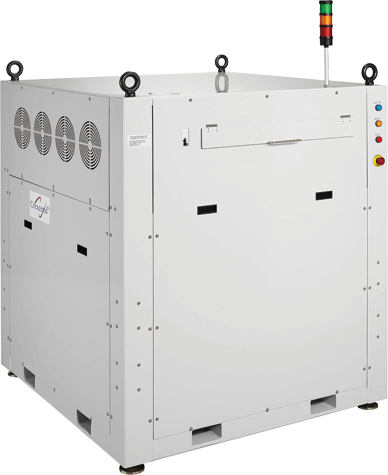Why Solid State
Menu
Why Choose Solid State Technology?
Innovations in semiconductor technology have paved the way for high-power, all-solid-state microwave generators, offering significant advantages over magnetron-based generators. Magnetron vacuum-tube technology has remained largely unchanged for over four decades, with limited improvements. Unfortunately, magnetrons come with several drawbacks, including restricted capabilities, poor reliability, and costly maintenance.
Here are some key reasons why solid-state microwave power outperforms magnetrons:
- Frequency Agility: Solid-state generators can seamlessly change frequency within the allocated ISM band while in operation. This offers two crucial benefits. First, the frequency can be finely tuned to the applicator, ensuring optimal power delivery for efficient heating of materials. Second, by sweeping frequency during operation, hot and cold spots within the applicator are redistributed, resulting in significantly improved heating uniformity. Magnetrons, on the other hand, are fixed to a single frequency.
- Precise Control: Solid-state generators provide complete control over output power, frequency, and phase, with rapid response times. They seamlessly integrate with PLC or plant DCS control systems, facilitating easy operation. In contrast, magnetron power control is slow and has limited stable power range.
- Versatile Operating Modes: Solid-state generators offer the capability of fast pulse output, which proves advantageous in certain applications. Additionally, Crescend Technologies generators include patented special operating modes specifically designed for gas plasma systems.
- Powerful Operating Software: The PrecisePower™ Windows-based software suite offers a comprehensive and user-friendly experience for controlling and evaluating your entire application system, from the generator to the load. It provides real-time metering of forward and reflected power output, SWR, and return loss. Furthermore, it features an integral scalar network analyzer that graphs and displays real-time forward power (S21) and return loss (S11) data across the entire band. The software also automatically selects the optimal operating frequencies or ranges of frequencies.
- High Reliability and Ease of Maintenance: Solid-state microwave generators exhibit superior reliability and serviceability compared to magnetrons. Magnetron tubes typically have a lifespan of 4000-6000 hours and require replacement costs ranging from $6,000 to $10,000 each. Furthermore, the output power of a magnetron decreases as it ages. In contrast, solid-state generators utilize transistors with lifespans in the hundreds of thousands of hours, powered by safe low DC voltage. Maintenance is simplified with solid-state generators. They are virtually maintenance-free and feature modular, plug-in construction. Microwave power modules or power supply units can be easily replaced within 30 minutes using simple hand tools. In contrast, magnetrons necessitate skilled technicians for servicing due to the high voltages and potent microwave energy present inside their cabinets. Solid-state generators are particularly well-suited for remote locations.
- Overall Lower Cost of Ownership: When comparing capital and operating costs, it’s crucial to consider the cost of service and downtime. Although solid-state generators have a higher initial purchase cost than magnetron units, their lower maintenance costs and reduced downtime often result in a lower overall cost of ownership.
- Scalability: Unlike magnetrons, solid-state generator outputs can be easily combined to deliver high power levels through a single waveguide feed.
| Characteristic | Magnetron | Solid State |
|---|---|---|
| Maximum power per unit | 75 or 100 kW, outputs cannot be combined | 50 kW, outputs can be combined to deliver 100 or 200 kW. |
| Operating frequencies | Fixed at 896, 915, or 922 MHz | Frequency agile from 902-928 MHz (896 available) |
| Power control range | 30–90 kW or 20–75 kW | 0-50 kW |
| Power on/off or change power level | 2–10 seconds | Nearly instantaneous |
| Warm-up or cool down time | 10 minutes | Zero |
| Power control accuracy | +/- 1 kW | +/- 100 watts |
| Automatic Load Tuning | No | Yes |
| Adaptive power control | No | Yes |
| Power and frequency stability | moderate | very high |
| Equipment cost | moderate | more expensive |
| Reliability | Poor to moderate | very high |
| Power element lifetime | About 6000 hrs.; warranty 3000 hrs. | 500,000+ hrs. |
| Serviceability | poor | very high |
| External control interface | PLC | PLC or computer via Ethernet |
| Pulse mode operation | No | Yes |
| Cooling | Water cooled | Water cooled |
| Reflected power protection | Internal circulator | Internal circulators and adaptive power control |
Generators
| High Power | Low Power | |
|---|---|---|
| L-Band PTL Family 902-938 MHz |

|

|
| PTL-50 | PTL-2.5 |
*Please note this is not an exhaustive list of available power sizes
Contact Us

Manufacturing Practice Leader
1-800.USA.MADE
Crescend Technologies, LLC
100 High Grove Boulevard
Glendale Heights, IL 60139
USA
